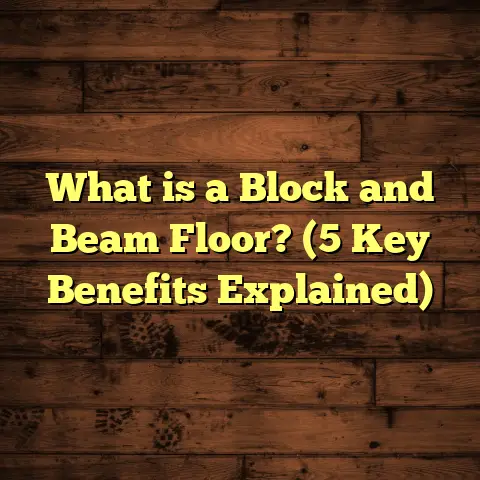What is a Floating Floor Fastening System? (5 Secrets Revealed!)
I still remember the first time I decided to install new flooring in my home—it was a mix of excitement and a bit of nervous anticipation. The thought of replacing old, scratched floors with something fresh and modern was thrilling. But soon, I hit a wall when I heard the term floating floor fastening system for the first time. What was it exactly? How did it work? And why did everyone seem to recommend it? Over time, I dug into the details and even installed several floors using this method. Today, I want to walk you through everything I’ve learned about floating floors, sharing some insider secrets and practical tips that I wish someone had told me back then.
What Is a Floating Floor Fastening System?
At its core, a floating floor fastening system means that the flooring material is installed without being nailed or glued directly to the subfloor beneath. Instead, the individual planks or tiles connect to each other and rest on top of an underlayment, “floating” above the subfloor rather than being fixed down.
Think of it like puzzle pieces snapping together on top of a soft base layer. This design allows the floor to expand and contract naturally with changes in temperature and humidity without damaging the installation or creating gaps.
Floating floors are commonly found in laminate flooring, engineered hardwood, and luxury vinyl planks (LVP). The fastening system typically involves tongue-and-groove edges or click-lock mechanisms that hold the planks firmly together. You’ll usually install a thin foam or cork underlayment beneath for added cushioning, moisture protection, and noise reduction.
Why Does This Matter?
This approach contrasts sharply with traditional flooring installations where nails or glue secure each plank directly to the subfloor. Those methods can be more labor-intensive and less forgiving if conditions change.
For example, if you live in an area with significant temperature swings—like the Midwest or Northeast of the U.S.—a nailed-down hardwood floor might crack or buckle as your home expands and contracts with changing seasons. Floating floors handle this better because they have room to move.
Let Me Break Down Some Numbers
On average, floating floor materials tend to cost between $2 and $8 per square foot depending on the type of flooring you choose. Laminate is generally on the lower end, while high-end engineered hardwood or luxury vinyl planks can push towards the higher end of that scale.
Labor costs for professional installation typically range from $1.50 to $4 per square foot. However, because floating floors are easier and faster to install (I’ve clocked myself at about 120 sq ft per hour for laminate), you often save on labor compared to traditional nailed or glued installations.
For instance, when I installed a 600 sq ft floating laminate floor in my living room a few years ago, I spent roughly $1,800 on materials and about $900 worth of labor if I had hired someone. Doing it myself cut that $900 labor expense completely, which was a huge win.
Secret #1: Your Floor Moves With Your Home—And That’s Good
One of the biggest “aha” moments for me was realizing how much a floating floor moves with your house. Houses aren’t static; they breathe and shift as temperatures rise and fall and humidity fluctuates.
I live in Minnesota, where winters can plunge below -30°F and summers climb to over 90°F. That kind of swing causes wood framing and concrete slabs underneath your floors to contract and expand regularly.
When I installed a floating floor in my basement, I noticed no gaps or warping even after months of harsh winters. That’s because the floating system allows slight movement between planks without putting stress on any single piece or the overall installation.
Compare that to nailed-down hardwood floors I saw elsewhere in my neighborhood cracking or buckling during winter months due to lack of expansion space.
Floating floors require a small gap around perimeter walls—usually about 1/4 inch—to allow for this movement. This gap is later covered by baseboards or quarter rounds for a clean finish.
How Much Movement Are We Talking About?
According to industry standards, flooring can expand or contract up to 1/4 inch for every 10 feet of length depending on moisture content changes. So in a 20-foot-long room, you might expect up to 1/2 inch of movement during seasonal shifts.
A floating system accommodates this by letting planks slide slightly relative to one another without damage. If you tried this with glued-down planks? You’d risk buckles or cracks.
Secret #2: Underlayment Is More Important Than You Think
When I first started working with floating floors, I underestimated underlayment’s role. I thought it was just there for a bit of cushion. But it turns out underlayment does much more than soften your step—it protects against moisture, reduces sound transmission, and even helps insulate your floor.
Types of Underlayment
- Foam: The most common choice for laminate floors. It’s inexpensive ($0.20-$0.50 per sq ft) and provides basic cushioning plus some moisture barrier properties.
- Cork: A natural product offering superior sound dampening and thermal insulation. It costs more ($0.60-$1.00 per sq ft) but feels warmer underfoot.
- Rubber: Great for soundproofing but often pricier ($1+ per sq ft). Mostly used in commercial settings or multi-family buildings.
- Combination: Some underlayments combine foam with attached vapor barriers for extra moisture protection in basements or humid climates.
For my basement renovation project, I chose a waterproof foam underlayment with an attached vapor barrier for about $0.50 per sq ft extra. It prevented moisture issues from seeping up through the concrete slab—a problem I’d read about in local home improvement forums—and cut down on echoing footsteps significantly.
Thickness Matters
Underlayment thickness generally ranges from 2mm (about 0.08 inches) to 6mm (about 0.24 inches). Most laminate flooring manufacturers recommend around 3mm thickness as ideal—thicker can feel cushier but may cause problems with door clearance.
How Underlayment Affects Installation Time and Cost
Underlayment installation usually takes about 10-15 minutes per room for an average size (up to 400 sq ft). Its cost adds roughly $50-$100 per room depending on material choice.
Although it adds upfront cost and time, consider it insurance against noise complaints from upstairs neighbors or future moisture damage.
Secret #3: Plan for Waste—It’s Real and It Adds Up
Every flooring project produces waste—cut-offs, mistakes, damaged pieces—and you need extra material beyond just your room’s square footage.
When I first started flooring projects years ago, I made the mistake of ordering exactly what my rooms measured—only to run short halfway through installation.
How Much Extra Should You Order?
A safe rule of thumb is 5%-10% extra material depending on:
- Room shape complexity (more corners = more waste)
- Pattern type (herringbone or diagonal cuts produce more waste than straight lay)
- Installer experience level (DIYers tend to produce more scrap)
For example: On a simple rectangular 400 sq ft room with straight-laid laminate planks, 5% extra (20 sq ft) is usually enough.
In contrast, a complex kitchen remodel with multiple angles might push that waste factor closer to 10% (e.g., if room size is 400 sq ft, order 440 sq ft).
Why Does Waste Matter Beyond Material Costs?
Running out mid-project means costly delays waiting for new shipments—and potential color variations between batches if your original lot is no longer available.
I now use FloorTally whenever planning flooring projects because it automatically factors in waste percentage based on room geometry inputs. It saves me from overbuying too much or underestimating by a wide margin—plus gives me detailed cost breakdowns including labor rates and local pricing.
Secret #4: Floating Floors Aren’t Just for Homes
Most people think floating floors are mainly for residential use—and they are popular there—but more builders are choosing them for commercial spaces too.
In one commercial office project I managed in downtown Chicago last year, we installed over 1,200 sq ft of commercial-grade laminate floating flooring designed for heavy foot traffic environments.
Why Commercial Spaces Are Using Floating Floors
- Faster installation means less downtime for businesses
- Easier repairs mean less disruption in busy office settings
- Ability to install over existing floors reduces demolition waste
- Improved sound dampening helps open office environments
The client saved about 20% on labor compared to traditional glue-down vinyl tile options because we didn’t need adhesives drying time or extensive prep work.
Can Floating Floors Handle Heavy Traffic?
With the right materials—commercial-grade laminates or engineered hardwood designed for durability—they can stand up well to thousands of footsteps daily.
Some commercial warranties guarantee wear resistance for up to 25 years under heavy foot traffic scenarios. That’s comparable to glued-down systems but with easier maintenance down the line.
Secret #5: Installation Speed Depends Heavily on Material Choice
If you’re planning a project soon, you might wonder how long it will take. Installation speed varies quite a bit depending on which type of floating floor you choose.
Here’s what I’ve learned from hands-on experience:
- Laminate Flooring: The fastest to install due to uniform size and click-lock edges. An experienced installer can lay down about 100-150 sq ft per hour once acclimated to conditions.
- Engineered Hardwood: Requires more care with acclimation (usually 48-72 hours before installation) plus careful plank alignment due to natural grain variations. Expect around 75-100 sq ft per hour installation speed.
- Luxury Vinyl Plank (LVP): Slightly slower than laminate because cuts must be precise around fixtures and transitions but still quicker than glued-down vinyl tiles—roughly 120 sq ft per hour achievable.
What About DIY Installation?
I tackled my first floating floor by myself with laminate planks over two weekends—about 12 hours total including prep work. For beginners, expect slower progress initially as you get used to measuring cuts and snapping pieces together cleanly.
It’s worth noting that some floating floors come pre-finished with bevels or textures that make minor imperfections less noticeable—a big help if you’re new at installation.
More Things I’ve Learned Along the Way: Practical Tips & Insights
Now that we’ve covered the basics and some secrets behind floating floors, let me share some real-world insights from my projects:
Acclimate Your Flooring Before Installation
Most flooring manufacturers recommend letting your planks sit in the room where they’ll be installed for at least 48 hours before starting work. This allows the material to adjust to temperature and humidity conditions so it won’t expand or contract drastically post-installation.
I once skipped this step when rushing a project in Boston—big mistake! The floor expanded slightly after installation causing minor gaps along walls that needed fixing later.
Keep Expansion Gaps Consistent
You need to maintain expansion gaps along walls (usually about 1/4 inch) so your floating floor has room to move naturally without buckling later on. Use spacers during installation to keep this consistent all around.
Check Subfloor Condition Thoroughly
A floating floor is only as good as its foundation. Make sure your subfloor is level within 3/16 inch over 10 feet for best results—uneven surfaces can cause noisy “hollow” spots or uneven wear later.
If your subfloor is plywood or concrete, clean it thoroughly and fix any loose areas before laying down underlayment and flooring.
Don’t Forget Transitions Between Rooms
Floating floors often need transition strips where they meet other flooring types like carpet or tile. These strips cover expansion gaps and create smooth walking transitions between different surfaces.
In one project with multiple rooms having different flooring types, installing transition strips took almost as much time as laying the floor itself—don’t overlook them!
Cost Breakdown Example: Floating Floor Installation in My Home
To give you an idea of costs involved in a typical floating floor job, here’s a breakdown from one of my recent projects:
| Item | Unit Cost | Quantity | Total Cost |
|---|---|---|---|
| Laminate Flooring | $4 per sq ft | 600 sq ft | $2,400 |
| Underlayment | $0.40 per sq ft | 600 sq ft | $240 |
| Installation Labor | $3 per sq ft | 600 sq ft | $1,800 |
| Transition Strips | $150 flat rate | N/A | $150 |
| Miscellaneous Supplies | $100 | N/A | $100 |
| Total | $4,690 |
I saved around $1,800 by installing myself instead of hiring pros—though it took me about three full days including prep work and breaks!
A Look at Future Trends: What’s Next for Floating Floors?
Floating floor systems are evolving quickly thanks to advances in materials technology:
- Improved locking mechanisms make installs faster and more secure without gaps forming over time.
- Waterproof laminates and vinyls are becoming mainstream—great news if you want floating floors in kitchens or bathrooms without worry.
- Eco-friendly options like bamboo engineered hardwoods combined with recycled-cork underlayment are gaining popularity among environmentally conscious homeowners.
- Smart flooring embedded with sensors is emerging too—imagine floors that can detect temperature changes or foot traffic patterns helping with home automation!
Final Thoughts (Really!)
Floating floor fastening systems offer flexibility, ease of installation, durability, and cost savings that make them an excellent choice for many projects—from DIY home renovations to commercial office upgrades.
If you’re thinking about new flooring but feel overwhelmed by options or unsure how it all works together, take your time learning about floating floors first. Consider factors like moisture levels in your home, expected foot traffic, budget constraints, and whether you want to install yourself or hire someone else.
And don’t forget tools like FloorTally—they helped me avoid costly mistakes by giving detailed cost estimates factoring in local labor rates, material waste, and even delivery charges all at once.
So what about you? Have you tried installing a floating floor yourself? Or are you leaning toward hiring pros but want better insight first? Ask me anything—I’m happy to share tips from my own rollercoaster journey through flooring projects!
If you want me to expand on specific sections like installation steps, maintenance tips, or comparisons between floating floor types further let me know!





